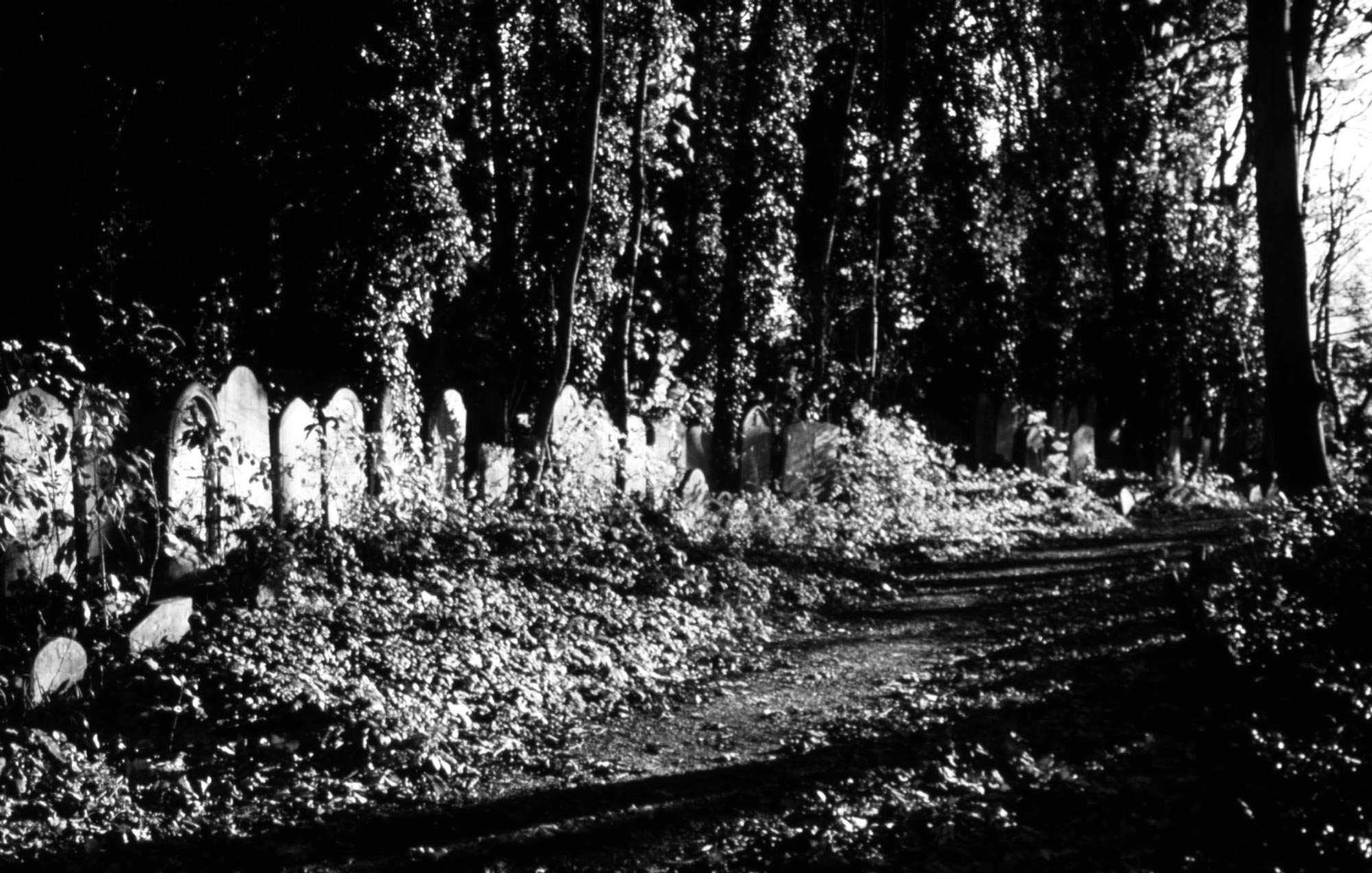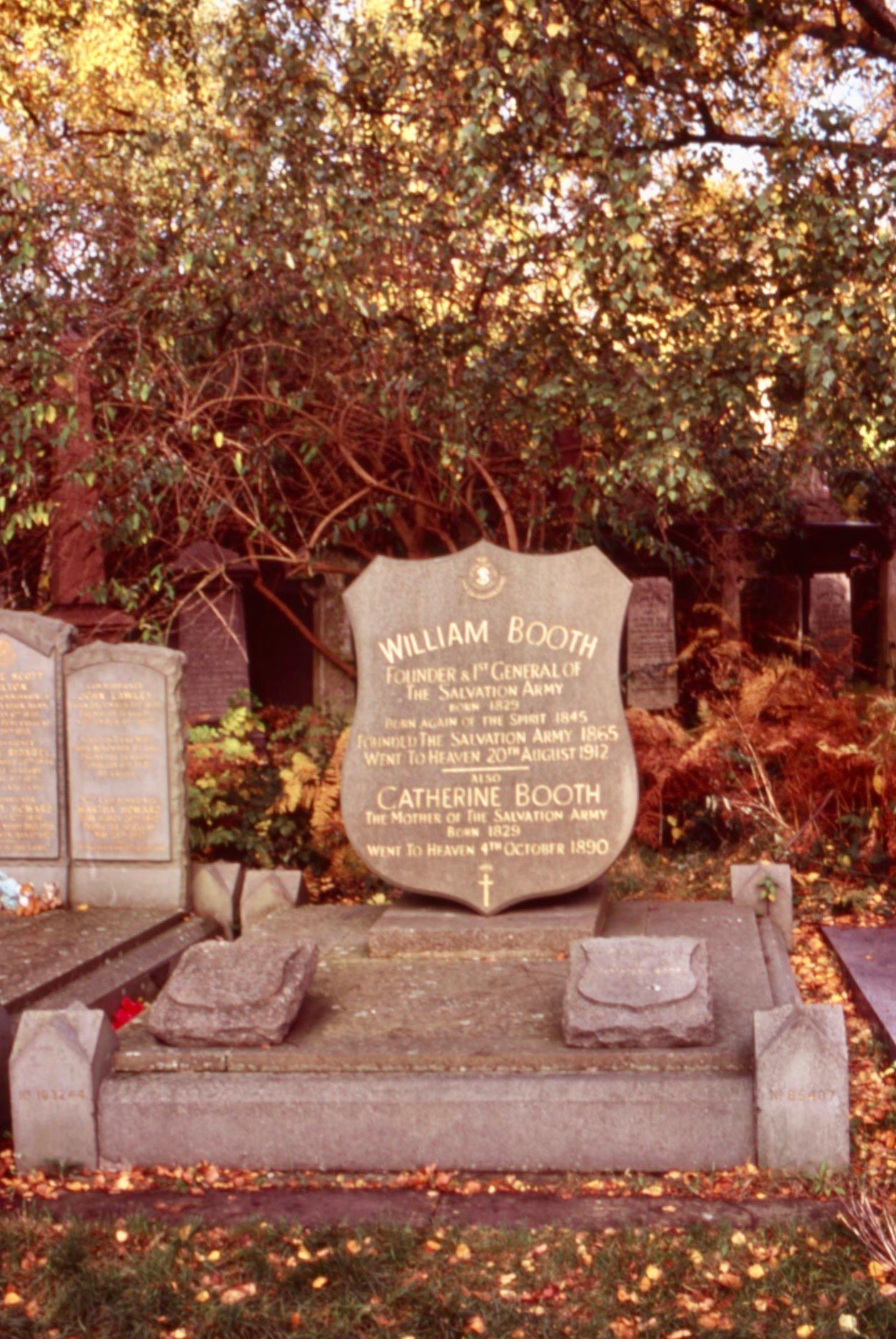Today was one of sunshine (not much) and showers (numerous). The morning having been predicted to be the driest, we were both out gardening early. Jackie was mostly planting, in and out of the greenhouse.
I managed considerable progress on weeding the Heligan Path, until a heavy shower drove me inside and I turned to WordPress matters.
After lunch I reached the kitchen door in order to complete my weeding task. As I reached the handle, heavier rain set in. Later I tried again. With the same result. I concluded that someone was having a laugh, and applied myself to scanning a number of the last few of my Magnificent Seven cemeteries series.
The first was misfiled from my Abney Park set of late 2009. Buried with ‘General’ William Booth (d. 1912) are Catherine, his wife (d.1890), Bramwell, their son (d. 1929), and their daughter, Florence (d. 1957). Booth was the founder and first ‘General’ of the Salvation Army.
Here is a link https://www.salvationarmy.org.uk to this Christian church and international charitable organisation reporting a worldwide membership of over 1.7 million, consisting of soldiers, officers and adherents collectively known as Salvationists.



The rest are from my visit to Tower Hamlets Cemetery in March 2009.


Living trees have caused much disturbance to the repose of the dead, such as the toppling of this fallen angel and the breaking of stonework.
The Llewellyn monument is perhaps noteworthy by association.
‘The life of Dr. Rees Ralph Llewellyn (Whitechapel 1850-1921) presents a good example of the fact that not all who lived in Whitechapel were doomed to spend their lives in poverty or gruelling labour. He was born in Whitechapel itself, the eldest son of Welsh medical practitioner Llewellyn Llewellyn, and had the surgery at 152 Whitechapel Road that was also the family home. Rees lived there for much of his life and following his mother’s early death, went on to follow in his father’s footsteps, as did his younger brother Walter.
Qualified as Matric. U. of London, 1869. Hon. Certif. in Obst., 1873. MRCS (Member of the Royal College of Surgeons, 1874), LRCP (Licentiate of the Royal College of Physicians, 1876), by 1888 he had become the medical officer to the East and East Central London districts and he maintained a surgery at 152 Whitechapel Road.
He was summoned by PC John Thain at approximately 4:00 a.m. on 31 August 1888 to attend Mary Ann Nichols, whose body had been found in Buck’s Row. He conducted a brief examination, pronounced her dead, and had the body transported to the Old Montague Street Workhouse Infirmary Mortuary. He was later recalled to the mortuary when more extensive injuries to the abdomen were discovered by Inspector John Spratling. At 10:00 a.m. on Saturday, 1 September, Llewellyn conducted the post-mortem examination.
Dr Llewellyn’s testimony at the Nichols’ inquest (in which he is erroneously identified as Mr Henry Llewellyn) was reported in The Times:
The injuries were from left to right, and might have been done by a left-handed person. All the injuries had been caused by the same instrument.”
The Times reported later that Dr Llewellyn had been recalled to the resumed inquest on the previous day and testified that “…since the last inquiry he had been to the mortuary and again examined the deceased. She had an old scar on the forehead. No part of the viscera was missing. He had nothing to add to his previous evidence.”
It appears that Dr. Llewellyn never married and lived most of his life with his siblings, first at the surgery in Whitechapel and leter (sic) in Stamford Hill where he and Walter shared medical practice.
Stamford Hill, in north London, was then a desirable suburb on the fringes of Hackney with fine huses (sic) and was no doubt a place of choice for those with better quality of life and of course, income. Llewellyn died there in 1921, but was buried at Tower Hamlets Cementery (sic) (Mile End), back in the heart of the district where he had served most of his years.’ (https://victorianwhitechapel.tumblr.com/post/170673724059/dr-llewellyn-dr-rees-ralph-llewellyn)
Mary Ann Nichols was the first discovered victim of Jack the Ripper, London’s notorious 19th century serial killer.
‘Some dozen murders between 1888 and 1892 have been speculatively attributed to Jack the Ripper, but five are considered canonical: Mary Ann Nichols (found August 31), Annie Chapman (found September 8), Elizabeth Stride (found September 30), Catherine Eddowes (found September 30), and Mary Jane Kelly (found November 9). All but one of Jack the Ripper’s victims were killed while soliciting customers on the street. In each instance the victim’s throat was cut, and the body was usually mutilated in a manner indicating that the murderer had at least some knowledge of human anatomy. On one occasion half of a human kidney, which may have been extracted from a murder victim, was mailed to the police. The authorities also received a series of taunting notes from a person calling himself Jack the Ripper and purporting to be the murderer. Strenuous and sometimes curious efforts were made to identify and trap the killer, all to no avail. A great public uproar over the failure to arrest the murderer was raised against the home secretary and the London police commissioner, who resigned soon afterward.’
The above paragraph is an extract from a fuller article on this mystery, its lasting popular interest, and some suspected perpetrators, contained in https://www.britannica.com/biography/Jack-the-Ripper
After I had done a Bart Simpson, for dinner this evening we enjoyed oven fish and chips, garden peas, pickled onions and gherkins, with which Jackie drank Hoegaarden and I drank The Second Fleet Limestone Coast Shiraz 2019.
For anyone not familiar with The Simpsons, I must explain that, not having used our super duper ovens to cook items from frozen before, and following the packet instructions to the letter, which the Culinary Queen never does, I had a wee bit of trouble carrying out the task and, like Bart, had to keep asking Marge what to do next. Eventually I was advised to pour the wine and the beer.
While we ate, hard hail hammered on the windows.

